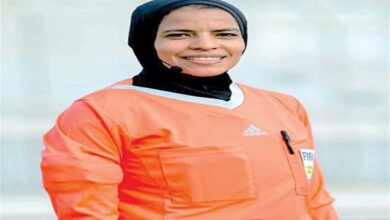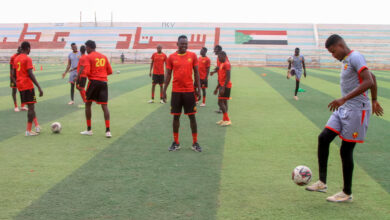The ground shakes. A cloud of dust rises on the horizon, growing steadily. From its heart comes a low, angry buzz, like a swarm of killer bees. The cloud thickens and stretches; a wall of sand now swiftly approaching, through which a series of dark, vibrating shapes are barely visible. The noise intensifies, splitting through the desert stillness like a thousand electric chainsaws as the sandstorm sweeps past, diminishing all senses. Finally, the dust settles, revealing an unusual sight and the force behind this Saharan blitzkrieg—fifteen extremely eye-catching automobiles parked side by side, engines purring, bright colors gleaming under the scorching sun.
Among the row of parked jeeps is a familiar shape—a dusty blue Toyota Land Cruiser. Its door swings open and driver Tarek el-Erian leaps out, looks around, and approaches Al-Masry Al-Youm. “Pretty exciting, huh?” the young pilot says.
These are the opening stages of the 2010 Egypt Rally Cup, an off-road rally car race organized and held by the Egyptian Federation for Motorsports. Once an obscure sport, designated for foreigners privileged with both the time and money to fly to exotic locations such as the Saharan Desert for the sole purpose of racing their cars over challenging terrain, rally car racing has, in recent years seen a significant increase in terms of Egyptian participants. This unexpected growth has resulted in, among many other things, events like the Egypt Rally Cup; a race populated entirely by local racers.
Despite starting off as an independent organization founded by a group of former and current racers, the EFMS was recently appointed by the National Sports Council to organize and regulate all automobile and karting events taking place in Egypt. The Rally Cup is only one of three main racing events which the organization holds every year, with the Rally de Pharaohs scheduled for September or October, and the Desert Challenge, set to wrap up the racing season sometime in November.
While last year’s inaugural edition of the Rally Cup was held in the Western Desert, this year’s event is in the picturesque seaside town of el-Gouna, and features a record-breaking 15 teams—the largest number of Egyptian racers participating in one event ever, and a step up from last year’s event, which consisted of 10 teams—also a record at the time.
“Any Egyptian who is serious about racing is here today,” says el-Erian, moments before a group of older racers, who have just arrived, envelop him in warm embraces. All around, racers—competitors by this time tomorrow—are greeting each other animatedly, laughing aloud and play fighting; discussing cars, inspecting engines; in short, clearly enjoying each other’s company. So much so, in fact, that Abdel Hamid Abou Youssef, founder of the EFMS and a rally car racer himself, practically has to scream–repeatedly–to get their attention. As the racers reluctantly settle down, “Mido” reminds them that they are gathered on this desert plain for a reason.
Despite the fact that, at this point, the race is not scheduled to begin for another twenty hours or so, Friday is still a busy day for the participating teams, who must undergo a series of inspections before they can be allowed to race. A process collectively known as “scrutineering” sees EFMS regulators carefully examining every participating car in order to determine whether or not it is fit to withstand the rigors of off-road rally racing. Bucket seats, roll-cages, circuit-breakers, and a variety of other safety precautions are checked for, and if found missing, the vehicle in question will simply not be allowed to participate.
With scrutineering mostly over, the cars set off, kicking off another blinding dust-storm, as they made their way into el-Gouna, heading towards Abou Tig Marina, for a short but flashy parade. Residents of el-Gouna gathered to take pictures and cheer on the racers as they slowly drove their heavily-modified vehicles under an inflatable Red Bull logo, a scene scored by deafening testosterone-enhancing electronica, courtesy of a truck/portable disco also provided by Red Bull. Children bounced around excitedly, girls whooped and screamed, while pilots and co-pilots confidently offered winks and thumbs-ups to anyone in the vicinity.
Following the parade and some last-minute scrutineering, the cars, along with the following crowds, headed back to the outskirts of el-Gouna, where a closed track had been set up beforehand by EFMS organizers. In individual turns, each participating car ran the track, its overall time determining its racing order for the actual race, which will begin on Saturday, concluding on Sunday.




